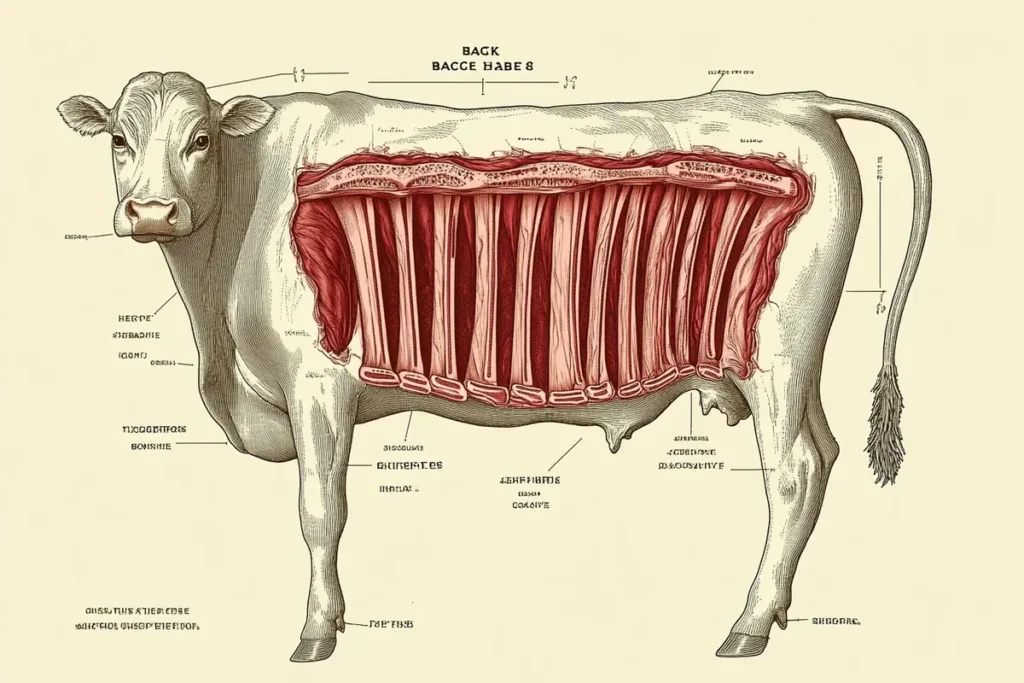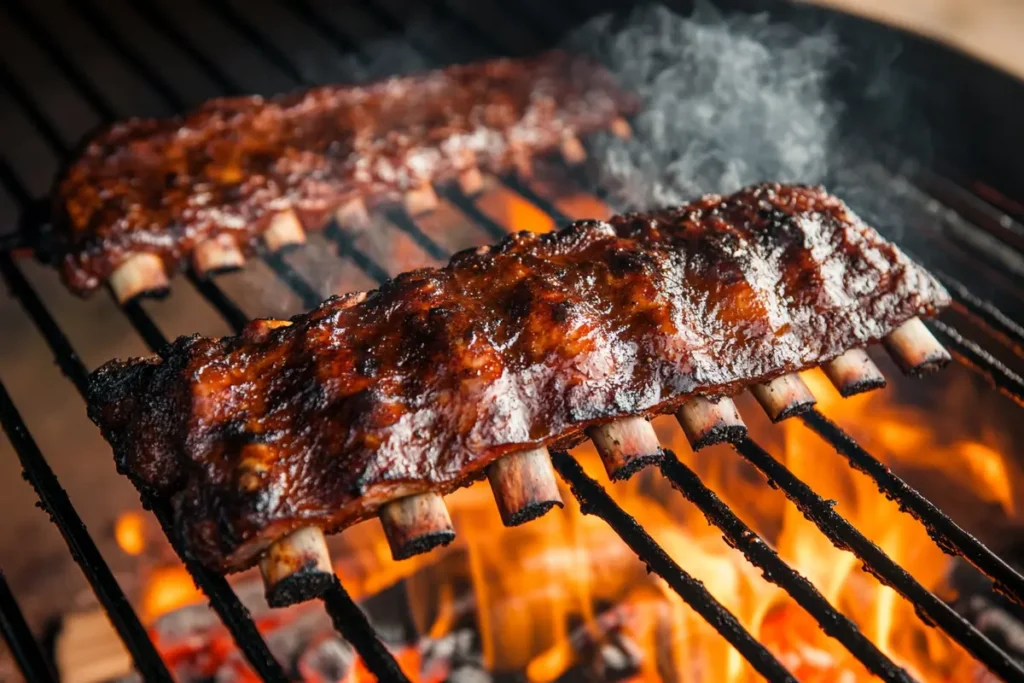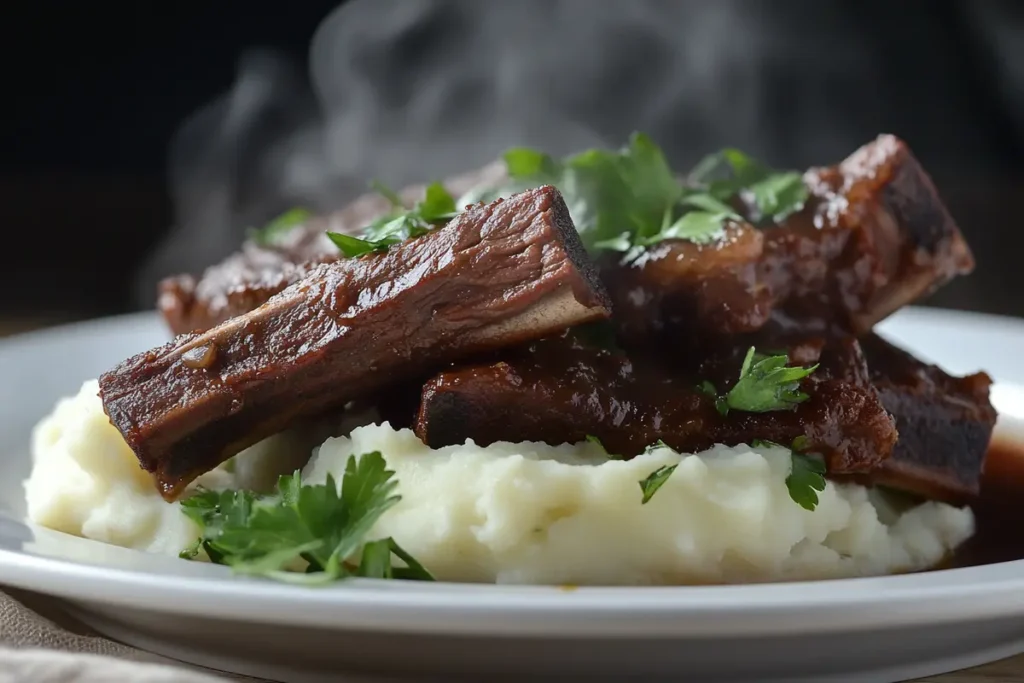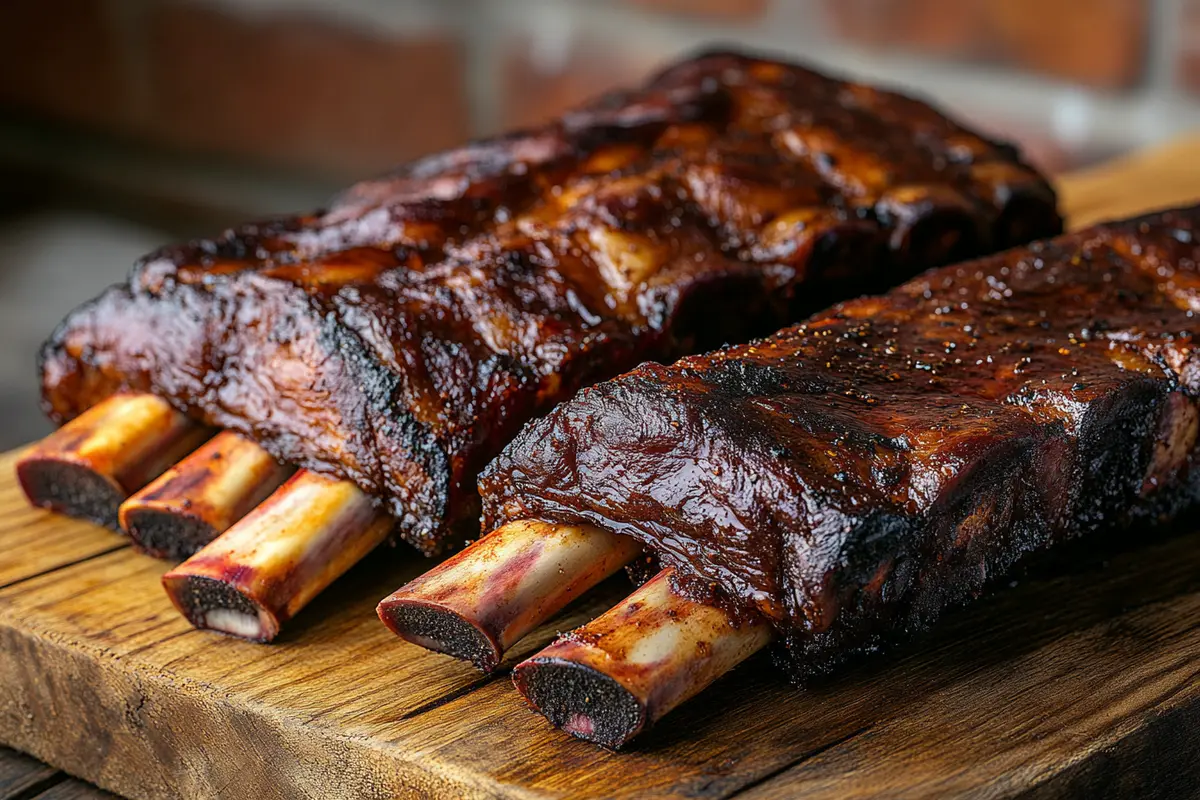Are beef back ribs same as beef ribs? It’s a common question, especially among BBQ lovers and home cooks. While they may sound similar, these cuts differ in flavor, texture, and cooking methods. In this article, we’ll explore the distinctions between them, dive into their unique qualities, and help you pick the perfect rib for your recipe.
Table of Contents
Understanding Beef Ribs
Overview of Beef Rib Cuts
The term “beef ribs” refers to multiple cuts from the rib section of a cow, including beef back ribs and short ribs. These cuts differ in their meat-to-bone ratio, fat content, and tenderness, making them suitable for different recipes.
Importance of Differentiating Between Rib Types
Choosing the right rib type ensures your meal turns out perfectly. Whether you’re grilling, smoking, or slow-cooking, understanding these differences helps you get the best flavor, texture, and value for your dish.
Anatomy of Beef Ribs
Location and Structure of Beef Ribs
Beef ribs come from the rib section of a cow, which spans ribs 6 through 12. This area includes several cuts, each with unique qualities. Beef back ribs are taken from the upper part of the rib cage, closer to the spine, where the prime rib roast is cut. These ribs tend to have less meat since much of it remains with the ribeye steaks or roasts.
On the other hand, short ribs come from the lower portion of the ribcage, near the chest or belly. They’re cut from the plate or chuck sections, making them meatier and more flavorful due to higher fat content. Each rib’s structure and position on the carcass play a significant role in its texture, cooking method, and flavor profile.

Differentiating Between Rib Cuts
The primary distinction between rib cuts lies in their meat-to-bone ratio and fat marbling. Back ribs typically have less meat, but what they lack in quantity, they make up for in tenderness and flavor. They’re ideal for grilling or smoking, where their natural juiciness can shine.
In contrast, short ribs are prized for their rich, beefy taste and marbled fat. They’re a favorite for slow cooking methods like braising, which break down the connective tissue, yielding a tender, melt-in-your-mouth result. Understanding these structural differences is the key to mastering beef ribs in the kitchen.
What Are Beef Back Ribs?
Source and Characteristics
Beef back ribs come from the upper part of the ribcage, near the spine, where prime cuts like ribeye steaks are sourced. These ribs are what’s left after the butcher removes most of the meat for ribeye or prime rib. Because of this, back ribs typically have less meat compared to other rib cuts, but they are still packed with flavor.
The bones in back ribs are long, curved, and thin, with small strips of meat between and on top of them. While they aren’t as meaty as other ribs, their natural marbling ensures a tender and flavorful bite when cooked correctly. This cut is often praised for its ability to absorb marinades and smoke, making it a popular choice for grilling and smoking enthusiasts.
Typical Meat Content and Flavor Profile
Although beef back ribs don’t carry large chunks of meat, what remains is incredibly tender and rich in flavor. The meat clings to the bone, creating a finger-licking experience that’s hard to beat. When cooked over low heat, back ribs develop a caramelized crust and a smoky, savory taste that barbecue lovers adore.
Because of their leaner nature, back ribs cook quickly compared to fattier cuts like short ribs. This makes them perfect for quick grilling sessions or as a smoky addition to your backyard barbecue spread.
What Are Beef Short Ribs?
Source and Characteristics
Beef short ribs are cut from the lower portion of the ribcage, specifically the plate or chuck section, closer to the belly. Unlike beef back ribs, short ribs are thick and meaty, with generous amounts of marbled fat that contribute to their rich flavor. These ribs are shorter in length compared to back ribs, which is how they get their name.
Short ribs are versatile and are often cut in different styles, such as English-cut (long and thick) or flanken-cut (thin, cross-sectioned ribs). Both styles are popular in various cuisines, ranging from American BBQ to Korean kalbi.
Typical Meat Content and Flavor Profile
Short ribs are a powerhouse of beefy flavor, thanks to their marbled fat and connective tissue. When cooked slowly, such as through braising or smoking, the fat melts, and the connective tissues break down, creating tender, succulent meat that falls right off the bone.
Unlike back ribs, short ribs are ideal for recipes that require longer cooking times, as the meat benefits from the extra time to absorb seasonings and develop depth of flavor. Their rich, hearty profile makes them a favorite for comfort foods like stews, braises, or slow-cooked BBQ dishes.
Key Differences Between Beef Back Ribs and Beef Short Ribs
Cut Location on the Carcass
The most notable difference between beef back ribs and beef short ribs lies in their origin. Back ribs are taken from the upper ribcage, close to the spine, where prime cuts like ribeye are carved out. This means they have less meat since most of it goes into high-value cuts. Short ribs, on the other hand, are taken from the lower ribcage, near the belly or chest. This area yields much meatier ribs, with ample marbling and connective tissue.
Meat-to-Bone Ratio
One major contrast is the meat-to-bone ratio. Back ribs typically have more bone than meat, with small strips of tender meat nestled between the bones. In contrast, short ribs are meatier, with thick chunks of flavorful beef resting atop the bones, making them more filling and satisfying.
Fat Content and Marbling
Short ribs are known for their superior marbling and fat content. This makes them ideal for slow-cooking techniques that break down fat and connective tissue, resulting in incredibly tender and juicy meat. Back ribs, while flavorful, are leaner and better suited for quicker cooking methods like grilling or smoking.
Cooking Methods and Culinary Uses
Back ribs excel in high-heat cooking methods like grilling and smoking, where their tender meat can soak up smoky flavors and develop a beautiful charred crust. Their quick cook time makes them perfect for backyard barbecues.
Short ribs, due to their rich marbling, shine in slow-cooked recipes like braising, stews, or smoking. The longer cooking time allows the fat to render, and the connective tissue to break down, yielding a melt-in-your-mouth texture.
Other Types of Beef Ribs
Chuck Ribs
Chuck ribs are cut from the shoulder area of the cow, near the neck. These ribs are smaller and tougher compared to back ribs or short ribs but are still packed with flavor. They are a popular choice for slow-cooking methods, such as braising or slow roasting, which tenderize the meat and enhance its natural taste. Chuck ribs are often less expensive, making them a budget-friendly option for hearty meals.
Plate Ribs
Plate ribs, sometimes referred to as dinosaur ribs due to their size, come from the lower section of the ribcage, near the belly. These ribs are massive, meaty, and packed with marbled fat, making them ideal for smoking or slow cooking. They’re a favorite among barbecue enthusiasts, delivering a deep, beefy flavor that’s perfect for large gatherings or indulgent feasts. Plate ribs are less common at grocery stores but are highly sought after in BBQ competitions.
Flanken Cut Ribs
Flanken cut ribs are thinly sliced cross-sections of short ribs that include multiple small bones. This cut is popular in cuisines like Korean and Hawaiian dishes, such as kalbi or teriyaki ribs. Flanken ribs cook quickly due to their thinness and are perfect for marinating and grilling, where they develop a caramelized crust and tender texture.
Selecting the Right Rib Cut for Your Recipe
Factors to Consider
Choosing the right rib cut depends on several factors, including the cooking method, flavor preference, and occasion. If you’re looking for tender, quick-cooking ribs for grilling or smoking, beef back ribs are an excellent choice. Their lean meat absorbs marinades and smoky flavors beautifully, making them ideal for a backyard barbecue.
For slow-cooked dishes like braises or stews, beef short ribs are your go-to option. Their marbled fat and connective tissue render down during extended cooking, delivering a rich, beefy flavor and a melt-in-your-mouth texture. Plate ribs are perfect for bold, large-scale BBQ projects, while chuck ribs work well for budget-friendly meals that don’t skimp on taste.
Recommendations for Various Dishes
- Grilling and Smoking: Use beef back ribs or flanken-cut ribs for quick, flavorful results.
- Slow Cooking and Braising: Opt for beef short ribs or chuck ribs to achieve tender, hearty meals.
- Special Occasions or BBQ Feasts: Choose plate ribs for their impressive size and bold flavors.
Cooking Techniques for Beef Ribs
Preparing Beef Ribs
Preparation is key to bringing out the best in any rib cut. Start by trimming excess fat or silver skin from the ribs to prevent chewiness. For maximum flavor, season generously with a dry rub or marinade. Let the ribs rest for at least an hour or overnight in the refrigerator to absorb the flavors. If smoking or slow-cooking, consider using a mix of spices that complement the meat’s natural richness.
Grilling Beef Back Ribs
Grilling is one of the most popular methods for cooking beef back ribs. Use medium heat to sear the ribs first, locking in the juices. Then, move them to indirect heat and cook slowly, basting occasionally to enhance their flavor. Grilled back ribs develop a crispy, smoky crust while staying tender on the inside.

Smoking for Rich Flavor
Smoking is perfect for larger cuts like plate ribs or short ribs. Use a low-and-slow approach, keeping the smoker at 225–250°F. Hickory, oak, or mesquite wood chips can add robust, smoky flavors that complement the meat. Smoke for 4–6 hours, spritzing with apple juice or broth to maintain moisture and deepen the crust.
Braising for Tender Short Ribs
Braising works wonders for beef short ribs. Sear the ribs on high heat to develop a golden crust, then simmer them in a flavorful liquid like beef broth, tomato sauce, or soy-based mixtures along with aromatics. Cover and cook slowly at low temperatures until the meat falls off the bone, usually 3–4 hours. This technique is excellent for creating hearty, comforting dishes.
Slow Cooking for Convenience
For a hands-off approach, use a slow cooker. Place beef short ribs or chuck ribs in the cooker with your favorite sauce or broth, along with vegetables like onions and carrots. Let them cook on low for 6–8 hours, resulting in tender, flavorful meat with minimal effort.

Nutritional Information
Caloric Content
Beef ribs are a rich source of energy, but the caloric content varies between cuts. Beef back ribs are leaner, offering fewer calories compared to short ribs, which are higher in fat. A typical serving of back ribs provides about 200–250 calories, depending on the preparation, while short ribs can range from 300–400 calories per serving due to their higher fat content.
Protein and Fat Levels
Both back ribs and short ribs are excellent sources of protein, essential for muscle building and repair. Back ribs deliver approximately 20–25 grams of protein per serving, making them a great option for lean protein intake. Short ribs, on the other hand, pack slightly less protein but make up for it with a richer fat profile, which contributes to their tenderness and flavor.
Vitamins and Minerals
Beef ribs are loaded with essential nutrients. They’re a great source of iron, which supports red blood cell production, and zinc, crucial for immune function. Additionally, they provide B vitamins like B12 and niacin, which help maintain energy levels and a healthy nervous system. Slow-cooked cuts like short ribs often retain more nutrients due to the gentle cooking process.
FAQs About: Are Beef Back Ribs Same
Which is more tender: back ribs or short ribs?
Both can be tender when cooked correctly, but short ribs are typically more tender because of their higher fat content and marbling. Slow-cooking methods allow the fat and connective tissue to break down, resulting in a melt-in-your-mouth texture.
Can I substitute beef back ribs for short ribs in recipes?
It depends on the recipe. Back ribs work well in dishes requiring quick cooking methods like grilling or smoking. However, they may not be suitable for recipes requiring extended cooking, such as braises, where short ribs excel.
What are the best side dishes to serve with beef ribs?
Beef ribs pair well with classic sides like mashed potatoes, coleslaw, roasted vegetables, or cornbread. For a lighter option, consider a fresh green salad or grilled asparagus to complement the richness of the ribs.
How do I select quality beef ribs at the butcher?
Look for ribs with a deep red color and avoid cuts with excessive liquid or grayish tones. For back ribs, choose cuts with a decent amount of meat on the bones. For short ribs, opt for ones with visible marbling and even layers of fat for the best flavor and tenderness.
Conclusion
Are beef back ribs same as beef short ribs? They may come from the same rib section, but their differences in meatiness, fat content, and cooking methods make them unique. Beef back ribs are perfect for quick grilling, while short ribs excel in slow-cooked dishes. By choosing the right cut for your recipe, you’ll unlock the full potential of these flavorful and versatile ribs!

